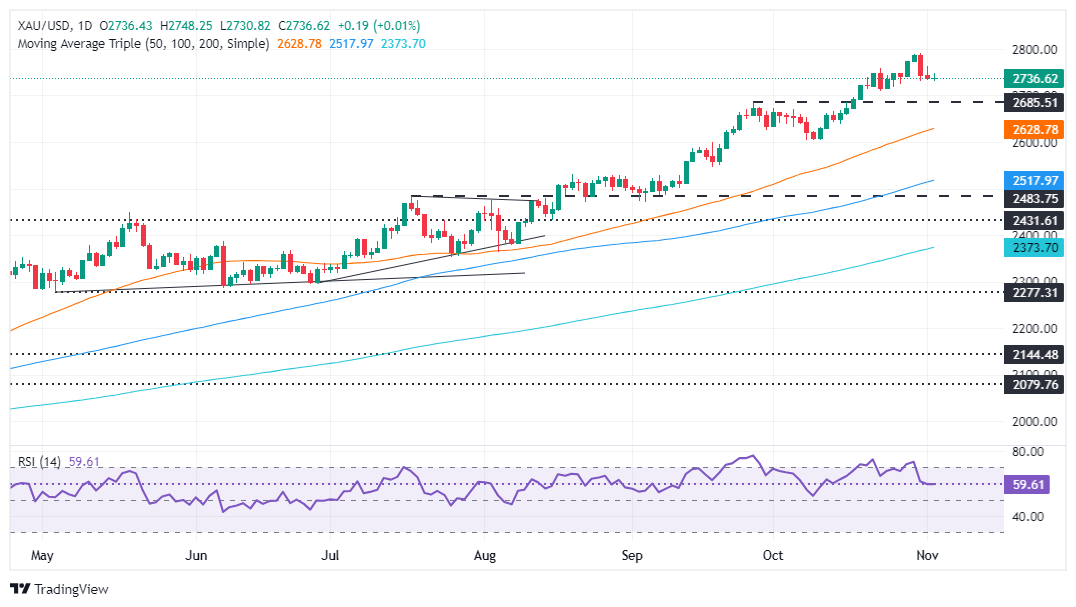Gold holds steady amid US election woes, Fed rate cut anticipation
- Gold prices stabilize, with year-to-date gains exceeding 30% amid market turbulence.
- US Treasury yields dip; USD weakens as investors await Fed's 25 bps rate cut.
- Analysts suggest a Trump victory could boost gold further due to inflation concerns.
Gold prices remained choppy during Monday’s session as the US presidential election continued amid uncertainty about who would win the White House. Additionally, this week, the US Federal Reserve (Fed) is expected to lower rates at the November 6-7 meeting.
The XAU/USD trades at $2,736, virtually unchanged. Yields in the US 10-year benchmark note have fallen eight basis points, after hitting 4.388% last week, sitting at 4.30% at the time of writing. In the meantime, the Greenback, as measured by the US Dollar Index (DXY) performance, tumbled over 0.40%, down to 103.90.
Wall Street is focused on the outcome of the US presidential election. Opinion polls show Democratic candidate Kamala Harris and Republican Donald Trump in a technical tie. A Reuters poll showed concerns that the US could face a similar election crisis post-Trump’s 2020 election defeat.
By Thursday, the Federal Reserve is expected to lower borrowing costs by 25 basis points to the 4.50%-4.75% range. October’s US economic data revealed that the US jobs market remains solid, lowering the odds of the US hitting a recession.
Analysts at TD Securities said “If Trump wins, I think, Gold does well here. We're probably worried a little bit more about inflation with all the tariffs that he's talking about.” Bullion is a hedge in tough and uncertain economic and political times.
The golden metal has enjoyed a rally of over 30% in 2024, and has recorded all-time highs, which sits at $2,790 at the time of writing.
Daily Digest Market Movers: Gold price consolidates amid US Presidential election
- The US Census Bureau reported that US factory orders in September contracted by -0.5%, slightly more than the expected -0.4%, but there was an improvement over August's -0.8% decline.
- Last week’s rising US inflation and dismal jobs report raised the chances of the Federal Reserve reducing rates in 0.25% chunk sizes.
- The Federal Open Market Committee (FOMC) is anticipated to cut rates by 25 bps at its November 7 meeting.
- Data from the Chicago Board of Trade, based on the December fed funds rate futures contract, indicates that investors are pricing in 50 basis points (bps) of Fed easing by the end of the year.
XAU/USD Technical Outlook: Gold price retreats below $2,750 as bulls take a breather
Gold prices remain consolidated. The XAU/USD fluctuated between $2,730 and $2,748 during the trading day, with no catalyst for moving it outside of those boundaries.
Momentum remains bullish, as depicted by the Relative Strength Index (RSI), though buyers seem to have lost a step as the RSI edges lower in bullish territory.
Gold buyers need to reclaim the psychological $2,750 figure for a bullish continuation. Once cleared, the next stop would be the record high at $2,790. Conversely, if XAU/USD registers a daily close below $2,750, further weakness lies ahead.
The first support would be the October 23 low at $2,708. Once surpassed, the next stop would be $2,700, followed by the September 26 swing high, which turned support at $2,685, and by the 50-day Simple Moving Average (SMA) at $2,628.

Gold FAQs
Gold has played a key role in human’s history as it has been widely used as a store of value and medium of exchange. Currently, apart from its shine and usage for jewelry, the precious metal is widely seen as a safe-haven asset, meaning that it is considered a good investment during turbulent times. Gold is also widely seen as a hedge against inflation and against depreciating currencies as it doesn’t rely on any specific issuer or government.
Central banks are the biggest Gold holders. In their aim to support their currencies in turbulent times, central banks tend to diversify their reserves and buy Gold to improve the perceived strength of the economy and the currency. High Gold reserves can be a source of trust for a country’s solvency. Central banks added 1,136 tonnes of Gold worth around $70 billion to their reserves in 2022, according to data from the World Gold Council. This is the highest yearly purchase since records began. Central banks from emerging economies such as China, India and Turkey are quickly increasing their Gold reserves.
Gold has an inverse correlation with the US Dollar and US Treasuries, which are both major reserve and safe-haven assets. When the Dollar depreciates, Gold tends to rise, enabling investors and central banks to diversify their assets in turbulent times. Gold is also inversely correlated with risk assets. A rally in the stock market tends to weaken Gold price, while sell-offs in riskier markets tend to favor the precious metal.
The price can move due to a wide range of factors. Geopolitical instability or fears of a deep recession can quickly make Gold price escalate due to its safe-haven status. As a yield-less asset, Gold tends to rise with lower interest rates, while higher cost of money usually weighs down on the yellow metal. Still, most moves depend on how the US Dollar (USD) behaves as the asset is priced in dollars (XAU/USD). A strong Dollar tends to keep the price of Gold controlled, whereas a weaker Dollar is likely to push Gold prices up.

